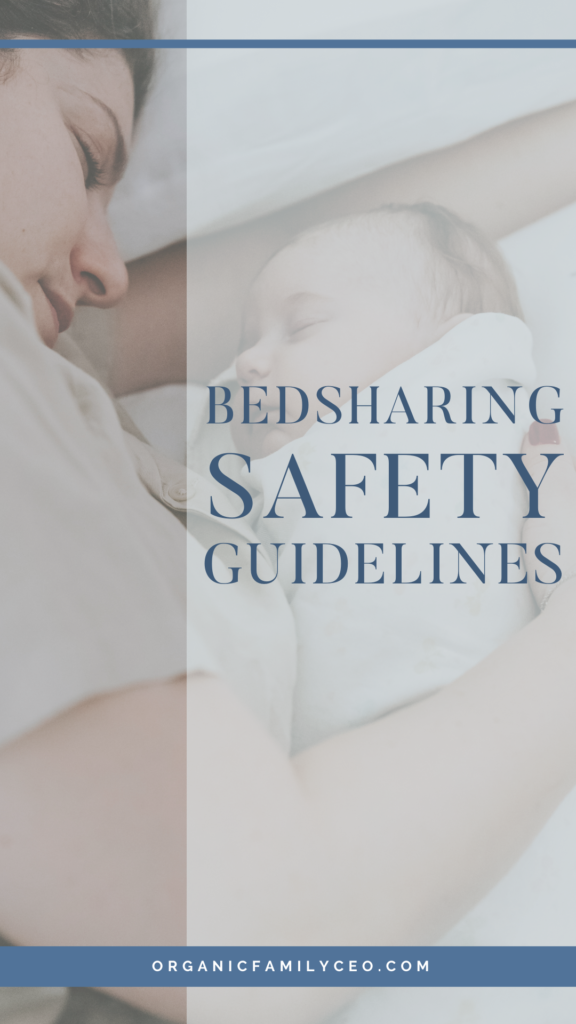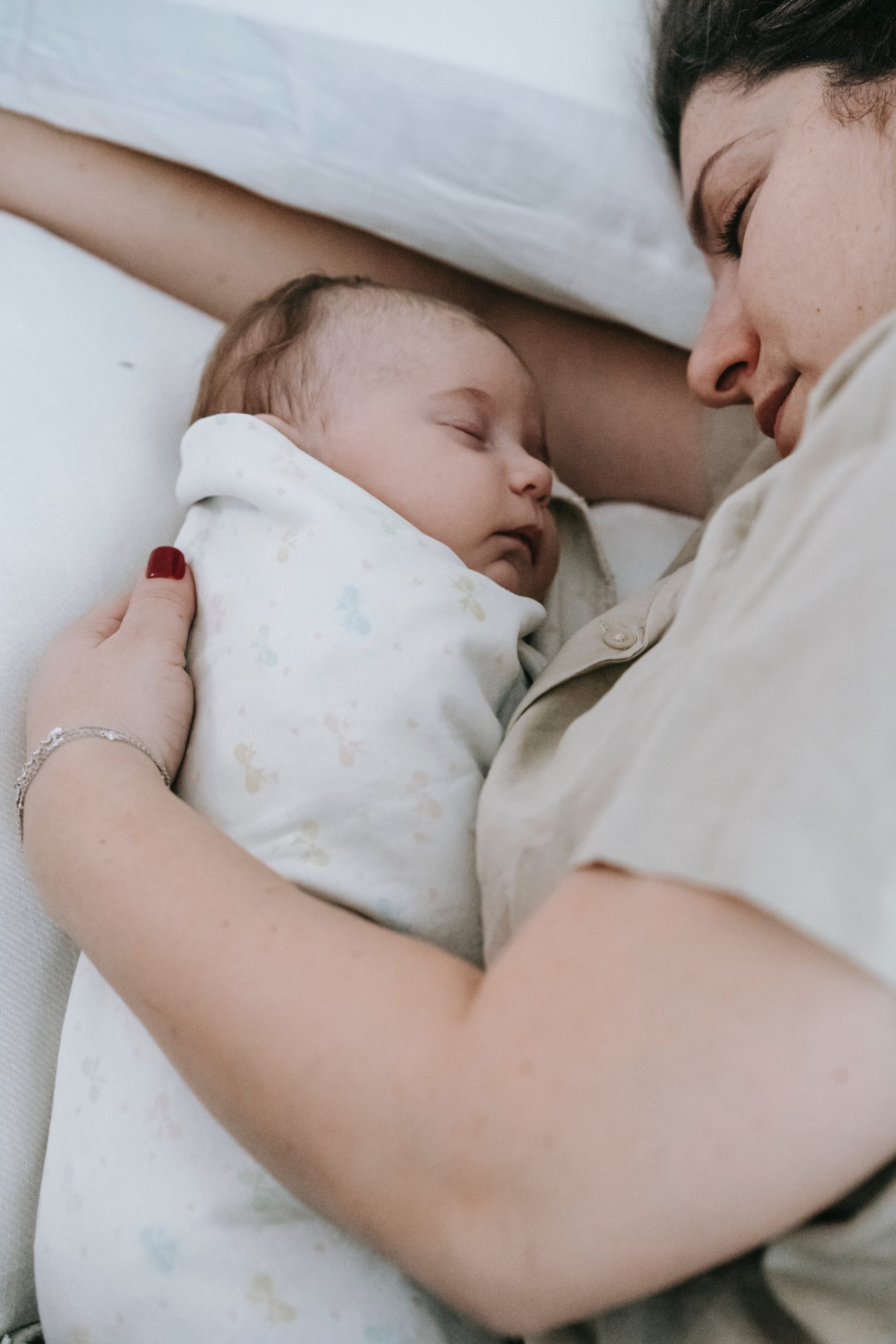If you had asked us about bedsharing before parenthood, we would’ve repeated the same devastating + controversial news headlines that everyone hears in the media.
But when our midwife encouraged us to truly educate ourselves on safe bedsharing practices, we found our uneducated opinion to be exactly that — uneducated.
Knowing what we know now + having successfully + happily bedshared for more than 4 years, we’re sharing some safety guidelines that are a MUST for parents considering bedsharing.

The Safe Bedsharing Prerequisites
Prerequisite: You need to be truly open to the idea.
If — for whatever reason — you agree that independent sleep is a developmental milestone + want to be close to offer your child comfort, but feel like you’re not okay with sharing a bed, then maybe co-sleeping is the better choice for you.
Note: “Bedsharing” is sharing a sleeping surface with your child, whereas “co-sleeping” is sharing a sleeping room with your child.
If you trust that independence is a developmental milestone + want to be close to offer your child comfort + you feel comfortable sharing a bed with your baby, then these guidelines are for you.
Prerequisite to discuss with your health provider: Baby was not born prematurely.
Premature babies need mom’s touch + connection even more so, but their possible respiratory challenges may put them at a higher risk of unsafe bedsharing.
If your baby was born prematurely, then consult your team of health providers for a specific recommendation based on your birth circumstances.
The Safe Bedsharing Guidelines
No. 1 — You must be breastfeeding.
Breastfed babies sleep differently from formula-fed babies, especially at the ages of 2-3 months. That age window is also the peak risk period for SIDS.
At this stage, a sleeping formula-fed baby is much harder to arouse than a sleeping breastfed baby. This matters significantly in bedsharing.
If a formula-fed baby were to slip under the covers accidentally while sleeping next to their mother, their chances of waking + alerting her of the danger are much lower than would be a breastfed baby.
Breastfeeding mothers also sleep differently than formula-feeding mothers in that they appear to be more in-tune to their babies during the night, which means they may be more easily aroused + more likely to wake if their baby ever stopped breathing or slipped under the blanket.
Breastfeeding mothers also tend to sleep in different positions — usually oriented more towards their babies + curling up around them in a way that creates a space with their bodies for their baby to sleep in.
All of these reasons make it imperative that you only bedshare with your baby if you are breastfeeding. All formula-fed babies must have their own sleeping surface. You can still co-sleep with formula-fed babies.
No. 2 — Both parents should be non-smokers.
The mother, especially, should not have ever smoked during pregnancy.
No. 3 — Both parents should not have consumed any alcohol, recreational drugs or prescription drugs.
Alcohol + drugs alter your natural sleep states, so you would run the risk of hurting the baby by rolling over onto them or not being alert enough to answer their cries if something was wrong.
Kevin would have the occasional cocktail or beer with dinner, so he would sleep on the couch that night.
No. 4 — Mom’s body should be able to feel the baby’s movements.
If you are excessively obese or an exceptionally deep sleeper, co-sleeping would be the safer option for you. You want to be sure your natural body can feel the baby touching you or hear the baby crying for you.
No. 5 — Parents should not be “overly tired”.
We laughed when I first read that guideline, too.
Use your best instincts on this one, but a good rule of thumb is that you should have not had less than 5 hours of sleep in the last 24 hours.
For times when you are overly tired, do co-sleeping with your baby sleeping on his/her own designated bed.
We never want to be approaching a window of accidentally falling asleep with our baby in a compromising position.
No. 6 — Mom is always the barrier between others + baby.
The baby should never be in the middle of the bed + should never sleep next to the partner or any other siblings. They do not have the same natural biological safety sense that the mother has.
No. 7 — Firm sleeping surface designed for sleep.
Sofas, hammocks, beanbags, waterbeds, recliners, etc. are all too soft + run the risk of suffocating baby. Remove any memory foam toppers (and no memory foam mattresses!) from your firm mattresses + you’ll be good to go.
Even though there might be a comfort adjustment for you, your back will thank you! Chiropractors advise against memory foam materials + plush sleeping surfaces anyways.
No. 8 — Guard against your baby falling to the floor.
You can purchase safe sleeping mesh guardrails that attach to your bed, or inflatable bumpers that go under your bedsheets, if you’re concerned about your baby rolling away from you on the open side of the bed.
Many parents choose to make their bed a “floor bed” by putting their mattress directly on the floor until the baby can safely crawl up and down by themselves.
No. 9 — Sleep at breast-level.
Baby should sleep at the same level as mom’s breasts, not head-level. We want pillows to be far away from the baby.
Courtney chose to sleep on the edge of a small throw pillow tucked behind her (with a tightly fitted cover, not a pillowcase) for the first few months with the baby, if she used a pillow at all. It just takes some getting used to!
No. 10 — Keep blankets + loose clothing away from the baby.
Eliminating the risk of smothering helps parents sleep better + helps babies to not overheat.
Make sure you have sheets that fit the size of your bed properly.
Courtney actually wore an adult onesie for the majority of the baby’s first year + it was AWESOME. She stayed warm without fidgeting with blankets (which is a feat because Courtney’s always cold, even in the summer because Kev sets the thermostat to “arctic tundra”) + the front zipper made breastfeeding access so much easier.
When you wear pajamas, be sure to remove any drawstrings or things like bathrobe belts that could accidentally strangle the baby. You can just pull those out of the hood on your onesie altogether + tuck any hood into your sweatshirt + you’re good to go.
No. 11 — Tie long hair back.
If you have long hair, tying it back prevents smothering or strangling. Courtney’s hair was usually in a low messy bun at the nape of her neck.
No. 12 — Watch Mom + Baby’s positioning.
Mom’s position should create a protective frame around the baby.
Baby should be put to sleep on their back without a swaddle. A baby is unable to swat away unwanted covers or alert an adult body that it’s getting too close if their arms are stuck in the swaddle.
Additional Bedsharing Support Resources
- Is Sleeping with Your Baby as Dangerous as Doctors Say? (NPR.org)
- Mother-Baby Behavioral Sleep Laboratory — Safe Sleeping Guidelines (University of Notre Dame)
- Good Nights – The Happy Parents’ Guide to the Family Bed (KellyMom.com)
Let’s hear from you now: what questions do you have about bedsharing?
Share in the comments + you’ll see your questions answered next! You can also send us your questions via Instagram direct messages @organicfamilyceo. We’d love to connect with you + share more about our experience there.
